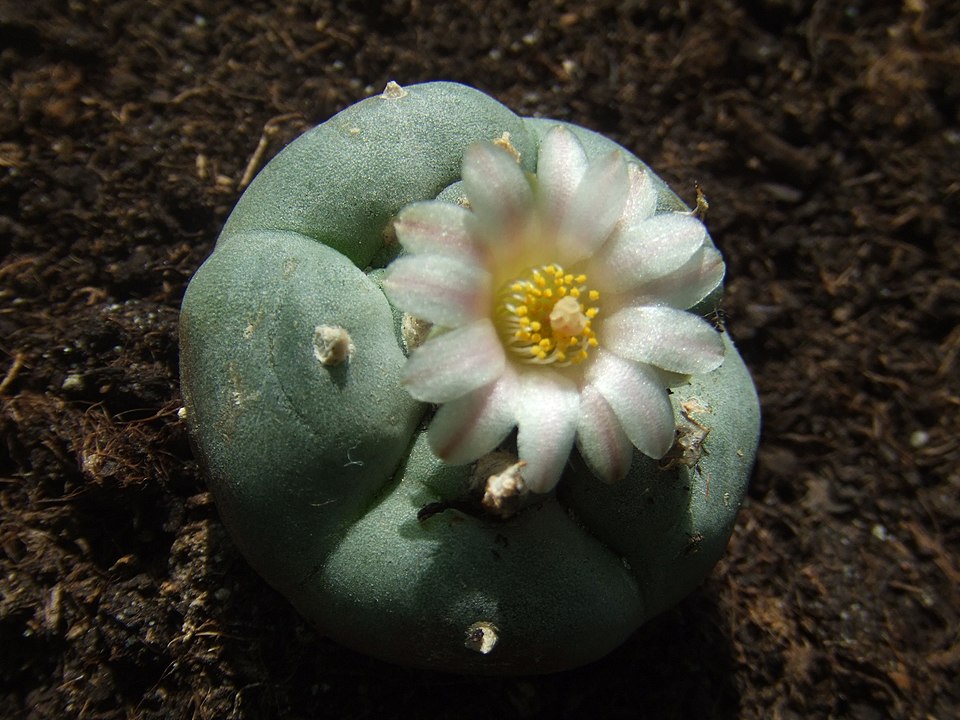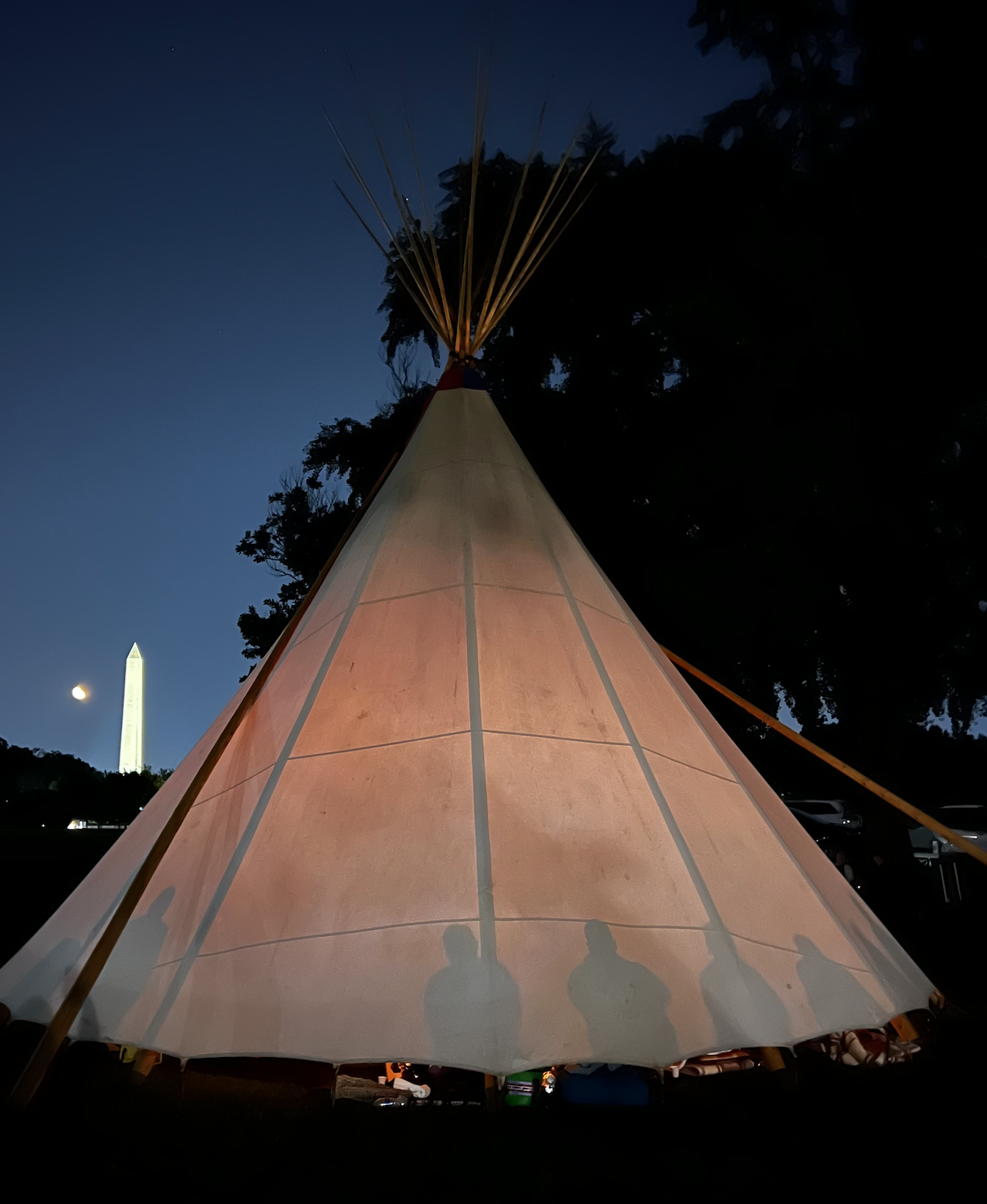
- Details
- By Annette McGivney, The Guardian
On the first day of autumn, evening temperatures near Window Rock, Arizona, were brisk. Beneath the late September sky, a traditional round hogan in this remote corner of the Navajo Nation was enveloped in darkness. Ten tribal members gathered inside.
This article was originally published in The Guardian and is used with permission.
After a dinner of mutton and fry bread, the group settled in a circle around a wood stove radiating with burning juniper, preparing to ingest what the Diné (Navajo) call azeé – the medicine.
Most people know azeé as peyote: a small, button-like cactus famed for its powerful psychoactive and healing properties. The cactus is extremely rare in the United States – it grows wild in only one part of Texas – and has been integral to traditional Indigenous American practices for thousands of years.
The goal of this ceremony was to guide Diné college students on their spiritual path. One young man struggling with alcohol abuse was especially in need of the medicine.
“When this is over, you will feel like a washrag with all the gunk wrung out of it,” the man’s grandmother told him.
Tonight, the ritual would be no different from what it was a century ago. There would be peyote songs and drumming. Margie Whitney-Silva, a certified spiritual leader known as a roadman, would supply the peyote in the form of a tea brewed from the cactus, carried in a large pickle jar. Eagle-feather fans and gourd rattles would be used as the jar was passed around.
During the 19th and first half of the 20th centuries, Indigenous Americans risked being thrown in jail for participating in such ceremonies because peyote was illegal under US law. Today, it is just the opposite. Peyote and mescaline – the hallucinogenic substance found inside the cactus – have become a darling of the psychedelic renaissance.
Peyote, mescaline and other hallucinogenics such as LSD, MDMA, ayahuasca and magic mushrooms are being touted for their capacity to revolutionise the treatment of PTSD, addiction and other health problems. In recent years, progressive politicians, doctors, community groups and Silicon Valley investors alike have thrown their weight behind decriminalization bills in dozens of US states and cities.
Their goal to spread the benefits of psychedelics may be well-intentioned, but for Indigenous Americans, the boom has a dark side that rarely comes up in venture capital pitches. Many Diné tribal members are describing this moment as a “peyote crisis” that threatens to appropriate and commodify their sacred way of life.
 Make A Donation Here
Make A Donation Here
Their concerns are multifold. Decriminalizing peyote could fuel poaching and a black market for the slow-growing cactus, whose limited habitat is already threatened by climate change and development. A sudden surge in demand might completely wipe out peyote from its natural environment, traditional practitioners say.
Then there are the deeper concerns about turning peyote and mescaline into an on-demand drug. Members of the Native American church of North America, an inter-tribal religion that revolves around the ancient practice of peyotism, are alarmed by pharmaceutical ventures seeking to create mescaline in a lab, in much the same way opium from the poppy flower was synthesized to create fentanyl.
Non-Indigenous leaders in the psychedelic space insist they are respecting Native American spirituality by using synthetic mescaline instead of the real thing. Dozens of Indigenous Americans interviewed for this story see it otherwise.
“How would Christians feel if Jesus Christ was cloned?” asked Justin Jones, a Diné peyote practitioner and legal counsel for the Native American church of North America, a non-profit organization that advocates for more than 300,000 members. “And while the real Jesus is protected, people could do whatever they wanted to the clone.”
At its core, the push to medicalize and mass-produce peyote and mescaline goes against the Indigenous American worldview of interconnectedness. There are no English words that describe how the spiritual character of peyote is inextricably intertwined with its hallucinogenic properties, the land where it grows and the Indigenous Americans who consume it, says Jones. In the Navajo language, Jones describes this harmonic oneness as azee’ hinááh biníłch’idiyin, be’adínídíín.
Creating synthetic mescaline in a lab or growing peyote in a greenhouse is a violation of natural law, and interrupts the unique symbiotic relationship with the plant. “What western scientists call mescaline is for us the essence of the medicine,” said Jones. “It is the soul of it and what makes it holy.”
Traditional peyote practitioners emphasise that they are not against the use of all psychedelics to innovate new treatments for addiction and PTSD. After all, their experiences prove just how powerful a healing tool these substances can be.
But they question why peyote and mescaline need to be used when a variety of other tools – especially psilocybin and MDMA – have proven effective. In rushing to medicalize peyote, which has a unique history and a sacred role for tribes, the decriminalisation movement risks perpetuating more harm in the name of doing good, they say.
“I’m all for healing,” said Cora Maxx-Phillips, a social worker, member of the Navajo Nation human rights commission and board member of the Council of Peyote Way of Life Coalition, a grassroots group in the Navajo Nation.
“But don’t do it at the expense of our people, who are trying to survive the multigenerational trauma inflicted upon us. Please, leave us alone.”
A fight for tradition
The ceremony near Window Rock was a private, emotionally grueling ritual that lasted all night.
Before the ceremony, Boyd Tsosie, another roadman who led the ritual, said the experiences of ancestors from three or four generations prior might surface. There would be little discussion; the goal was for each person to embark on their own inner journey in a kind of spiritual vision quest where the plant itself was the guide.
Tsosie emphasized that the practice of peyotism is as much about the ceremony as it is about the psychological effects. “We don’t view peyote as a substance the way non-Natives think about drugs,” said Tsosie. “There is no hallucination, no trip. The medicine is not used to numb the body like with other drugs, but to teach us.”
The gathering was sponsored by a local Diné chapter of the Native American church. Diné peyote practitioners and church members across the west describe peyote as one might a beloved family member. For them, peyote is a sentient being, a wise elder, a savior. They say the medicine is a gift from the creator that has made it possible to survive the traumas of colonization.
Fear and anger about what outside forces might do were palpable inside the hogan. Synthesizing, commodifying and enriching oneself at peyote’s expense is no way to treat a relative.
“We just have a sliver left of what we hold dear,” said Tsosie. “And we are praying and fighting to hang on to it.”
The way modern tribal members tell it, their ancestors were drowning in sorrow as a result of federal policies to seize their homeland and sacred sites, force their children into boarding schools and forbid the practice of traditional ceremonies. Peyote was sent by the creator as a kind of life raft that traveled from tribe to tribe, and those who jumped on, survived.
Radiocarbon studies of peyote buttons have dated the ritual use of Lophophora williamsii by Indigenous peoples back more than 5,000 years, but peyotism did not reach the Diné and other Plains tribes until the mid- to late 1800s.
Then in 1883, Congress passed the Religious Crimes Code, outlawing Indigenous American spirituality on the grounds that it hindered the federal policy of forced assimilation. In addition to peyote ceremonies, the sun dance and ghost dance were only practiced in secret, with violators subjected to jail time and the withholding of food rations.
Frank Dayish, 65, grew up on the north-western corner of the Navajo reservation and is descended from generations of peyote practitioners. He remembers how, when he was a young boy, tribal law enforcement would show up at his home and seize his community’s supply of peyote.
“The Navajo Nation police put all the peyote in a pile and poured gasoline on it and burned it,” said Dayish. “After they left, my father and his brothers would try to salvage what was too green to burn.”
The religious crimes law would not be repealed until 1978, when Congress passed the American Indian Religious Freedom Act (Airfa). But Airfa did not specifically address the use of peyote, which the federal government still classified as a highly addictive, schedule 1 drug. To distinguish themselves from the experimental hippies in the 1970s, Indigenous American peyote practitioners banded together to form a religion called the Native American church, demanding the same protections for their religious beliefs as anyone else in the US.
After decades of lobbying by Native American church groups, a 1994 amendment to Airfa finally gave protections to Indigenous American peyote users by stipulating that peyote can only be consumed by a “federally recognized tribal member” and “in connection with a traditional Indian religion”. The amendment also authorized tribal members to legally transport peyote across state lines.
“That was a huge victory for us,” said Dayish, who was president of the Native American church of North America at the time and heavily involved in lobbying for the amendment.
However, the hard-won exemption soon had unintended effects. Non-Indigenous New Age groups, such as James Mooney’s Oklevueha church and the Peyote Way Church of God, began offering access to the sacred cactus by claiming to follow the Native American church religion or their own brand of peyote religion.
In a precedent-setting 2004 case, the Utah supreme court ruled that Mooney was allowed to distribute peyote to his church members under the Religious Freedom Restoration Act. The result was to embolden psychedelic activists, who established plant-medicine churches on the grounds of religious freedom and to invigorate the decriminalization movement.
Today, one of the largest groups behind this movement is called Decriminalize Nature. The organization has 50 chapters across the United States, each comprising grassroots plant-medicine activists who advocate for legislation at state and local levels. Their logo features a peyote button, with a website that urges humanity to “draw upon the ancient wisdom of all our ancestors who lived from the Indigenous Worldview upon this Earth”.
Aikutzi Valadez, a member of Decriminalize Nature’s board, believes anyone should be allowed to grow peyote in private greenhouses for their personal use in order to increase supply and protect the cactus from being depleted in its native habitat. Valadez resides in California but is a member of the Huichol tribe in Mexico, which practices peyotism. She said that because she is not enrolled in a federally recognized tribe in the US, current drug laws prevent her from being able to engage in traditional peyote rituals where she lives.
“Native American church members need to look at the big picture,” she said. “If they are concerned about peyote becoming commodified, the solution is to make it widely available so it’s not just the pharmaceutical companies that have access. We are trying to liberate peyote because it is Mother Nature’s plant and should not be criminalized.”
This anti-corporate, nature-based ideology is appealing to many liberal-minded activists. But the philosophy of Decriminalize Nature, and groups like it, illuminates a tension at the heart of the peyote debate. Native American church leaders say groups describing themselves as culturally progressive are not only ignoring the requests of tribal governments but have done little to consult them on how peyote should be used by non-Indigenous people – if at all.
Valadez confirmed that Native American church leaders were not involved in developing Decriminalize Nature’s policy on peyote.
While the group’s policy is positioned as a “working plan” to help Native American church members and other Indigenous peyote practitioners protect their sacred medicine, Kevin Feeney, a cultural anthropologist at Central Washington University, sees echoes of the US’s colonial past in such efforts.
“There is the sentiment within the movement that decriminalizing these plants will result in this rosy, kumbaya situation where we all get to take peyote,” said Feeney, who has written extensively on peyote issues. “They are saying, let bygones be bygones … But, really, they are only asking Native people to be OK with this history.”
An $11bn industry
The psychedelics drug market is expected to be worth more than $11bn by the end of the decade. And while the use of psilocybin and MDMA in a clinical setting are farthest along, mescaline is the dark horse that some of Silicon Valley’s biggest investors are betting on.
One company riding the wave is Journey Colab, a pharmaceutical startup that’s developing psychedelic drugs and therapies. Since its founding in 2020, the company has raised more than $12m from high-level investors including Sam Altman, the founder of ChatGPT and an avid psychedelic proponent.
Journey Colab’s founder, Jeeshan Chowdhury, says people describe him as a “Silicon Valley tech bro”. He’s also a physician and the son of Indian immigrants.
He says he was intrigued by mescaline when he started the company. “The elders and respected leaders in the psychedelic space all told me mescaline was their favorite,” he said.
Peyote has long had a certain cachet in the psychedelics world. The English writer and philosopher Aldous Huxley first coined the term “psychedelic” in his 1954 essay The Doors of Perception to describe a mescaline trip. The perpetually intoxicated gonzo journalist Hunter S Thompson further popularised the drug in works like Fear and Loathing in Las Vegas.
While mescaline was studied for its therapeutic benefits in the 1950s and 1960s, it became overshadowed by LSD, which was cheaper and more accessible. Today, multiple companies, including several in Canada – where there are fewer restrictions on mescaline – are developing mescaline-based products and growing peyote in greenhouses.
The Canadian company Lophos Pharma, for instance, describes itself as “North America’s largest cultivation and research facility for peyote cactus” and is working on genetically modifying peyote to “decrease the peyote growth timeline from 13 years to as low as 3 years”.
Chowdhury says he set out to do things differently, and was influenced by Altman’s OpenAI model, which strives to share technological benefits with society at large. Alongside its drug development, Journey Colab set aside 10% of its founding equity for Indigenous groups, such as the peyote practitioners in the Native American church, as part of what it calls the Reciprocity Trust. Journey Colab has also signed a “patent pledge” that promises to use only synthetic mescaline in its products, and to not directly utilize any Indigenous resources.
Chowdhury says the fund is about respecting Indigenous American use of peyote and sharing financial benefits with Indigenous populations. “I believe if you have used any psychedelic personally or they are in any part of your professional career, we all owe our relationship to these medicines to the Indigenous communities who have stewarded this knowledge for generations,” Chowdhury said.
Help us defend tribal sovereignty.
At Native News Online, our mission is rooted in telling the stories that strengthen sovereignty and uplift Indigenous voices — not just at year’s end, but every single day.
Because of your generosity last year, we were able to keep our reporters on the ground in tribal communities, at national gatherings and in the halls of Congress — covering the issues that matter most to Indian Country: sovereignty, culture, education, health and economic opportunity.
That support sustained us through a tough year in 2025. Now, as we look to the year ahead, we need your help right now to ensure warrior journalism remains strong — reporting that defends tribal sovereignty, amplifies Native truth, and holds power accountable.
 The stakes couldn't be higher. Your support keeps Native voices heard, Native stories told and Native sovereignty defended.
The stakes couldn't be higher. Your support keeps Native voices heard, Native stories told and Native sovereignty defended.
Stand with Warrior Journalism today.
Levi Rickert (Potawatomi), Editor & Publisher

